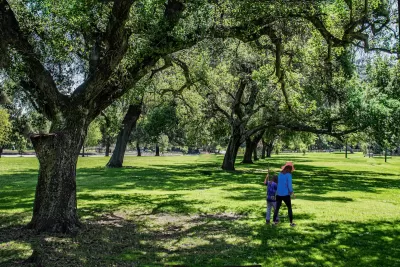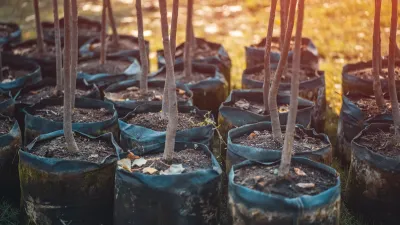Los Angeles County’s Community Forest Management Plan seeks to create a healthier, more equitable community forest by expanding tree coverage, engaging communities, and building resilience to climate impacts.

In an increasingly urbanized world, the role of nature within our communities has never been more important. The need to integrate trees and green spaces is essential not only for environmental sustainability but also for the health and well-being of residents. Community forestry, the practice of involving local communities in the management and care of community forests, stands as a key strategy to address these needs. By fostering a close relationship between people and their natural surroundings, community forestry ensures that the many benefits of trees are recognized, valued, and preserved for future generations.
The Los Angeles County Community Forest Management Plan (CFMP) was developed to address gaps in tree coverage and expand the benefits of trees to underserved communities. Through collaboration with key departments like Parks and Recreation, Public Health, and Public Works, as well as community-based organizations and residents, the CFMP aims to increase tree canopy coverage, focusing on areas that lack parks and green spaces. The Plan also addresses emerging threats, such as climate change and invasive pests, by implementing science-based practices and prioritizing community engagement to ensure a sustainable, inclusive approach to tree management and expansion.
The CFMP seeks to create a more equitable community forest through initiatives like increasing tree canopy in vulnerable areas, enhancing tree health and longevity, fostering community engagement, and preparing the community forest to adapt to climate challenges. By involving residents in all aspects of community forestry, L.A. County is building a foundation for long-term support and resilience. This forward-thinking plan not only benefits current residents but also paves the way for a healthier and greener future, particularly in communities historically impacted by environmental injustices.
FULL STORY: Trees for All

Trump Administration Could Effectively End Housing Voucher Program
Federal officials are eyeing major cuts to the Section 8 program that helps millions of low-income households pay rent.

Planetizen Federal Action Tracker
A weekly monitor of how Trump’s orders and actions are impacting planners and planning in America.

Ken Jennings Launches Transit Web Series
The Jeopardy champ wants you to ride public transit.

Washington Legislature Passes Rent Increase Cap
A bill that caps rent increases at 7 percent plus inflation is headed to the governor’s desk.

From Planning to Action: How LA County Is Rethinking Climate Resilience
Chief Sustainability Officer Rita Kampalath outlines the County’s shift from planning to implementation in its climate resilience efforts, emphasizing cross-departmental coordination, updated recovery strategies, and the need for flexible funding.

New Mexico Aging Department Commits to Helping Seniors Age ‘In Place’ and ‘Autonomously’ in New Draft Plan
As New Mexico’s population of seniors continues to grow, the state’s aging department is proposing expanded initiatives to help seniors maintain their autonomy while also supporting family caregivers.
Urban Design for Planners 1: Software Tools
This six-course series explores essential urban design concepts using open source software and equips planners with the tools they need to participate fully in the urban design process.
Planning for Universal Design
Learn the tools for implementing Universal Design in planning regulations.
Heyer Gruel & Associates PA
Ada County Highway District
Institute for Housing and Urban Development Studies (IHS)
City of Grandview
Harvard GSD Executive Education
Toledo-Lucas County Plan Commissions
Salt Lake City
NYU Wagner Graduate School of Public Service





























